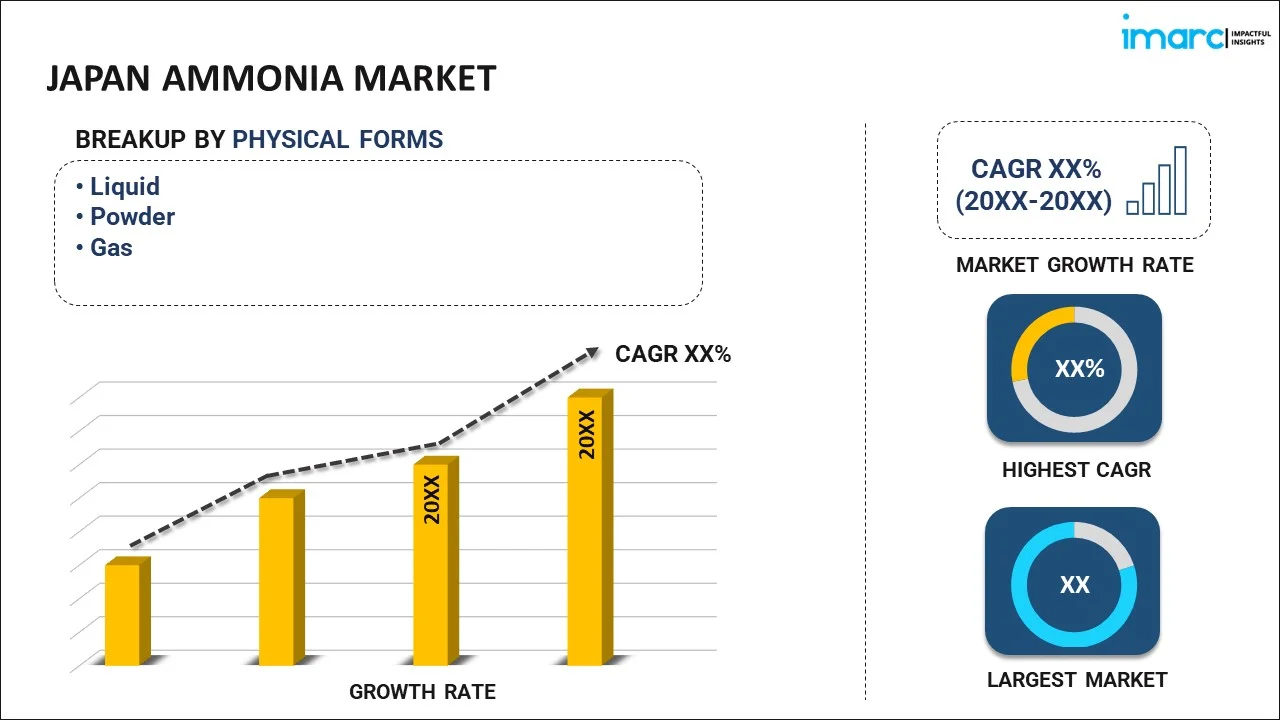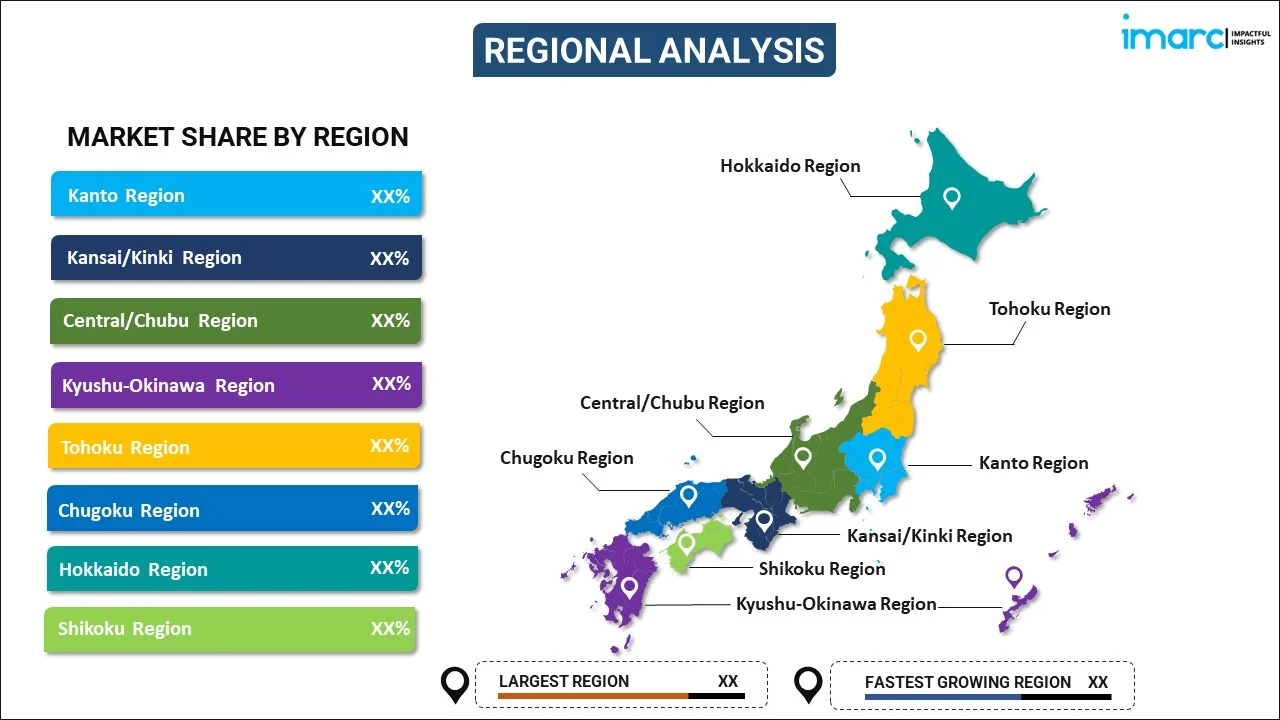
Japan Ammonia Market Report by Physical Form (Liquid, Powder, Gas), Application (MAP and DAP, Urea, Nitric Acid, Ammonium Sulfate, Ammonium Nitrate, and Others), End Use Industry (Agrochemical, Industrial Chemical, Mining, Pharmaceutical, Textiles, and Others), and Region 2025-2033
Market Overview:
Japan ammonia market size reached 1.3 Million Tons in 2024. Looking forward, IMARC Group expects the market to reach 1.9 Million Tons by 2033, exhibiting a growth rate (CAGR) of 4.1% during 2025-2033. The market is being driven by significant factors, including the extensive adoption of the product in water treatment and wastewater management processes, as well as the increasing development of infrastructure.
|
Report Attribute
|
Key Statistics
|
|---|---|
|
Base Year
|
2024 |
|
Forecast Years
|
2025-2033
|
|
Historical Years
|
2019-2024
|
| Market Size in 2024 | 1.3 Million Tons |
| Market Forecast in 2033 | 1.9 Million Tons |
| Market Growth Rate (2025-2033) | 4.1% |
Ammonia is an odorless gas with a distinct, sharp smell. Its chemical formula is NH3, consisting of a single nitrogen atom bonded to three hydrogen atoms. It exhibits high solubility in water and readily forms ammonium ions (NH4+) when dissolved in aqueous solutions. This chemical compound plays a crucial role in multiple industries and applications. One of its primary functions is in fertilizer production, where it provides essential nitrogen for plant growth. Additionally, it serves as a refrigerant due to its ability to absorb significant heat during evaporation, making it an effective coolant. Furthermore, it is employed in the manufacturing of cleaning agents, explosives, and various chemicals.
Japan Ammonia Market Trends:
With rapid urbanization, infrastructural development, and increasing construction activities across the globe, the demand for ammonia-based construction materials is escalating. For instance, it is widely used in the manufacturing of construction materials, such as adhesives, coatings, and resins. It is an essential component in the production of particleboards, plywood, laminates, and various synthetic materials used in construction applications, which is acting as another significant growth-inducing factor. Along with this, ammonia finds extensive application in water treatment processes and wastewater management, thereby positively influencing the regional market. It is commonly used in both industrial and municipal wastewater treatment plants to remove contaminants and pollutants through processes, including biological nutrient removal (BNR). In addition, its versatility as a cleaning agent extends to industrial cleaning, where it is used in equipment maintenance, degreasing, and stain removal. The expanding cleaning industry, driven by rising cleanliness standards, is contributing to the growth of the market. Moreover, the expanding cosmetics and personal care industry, driven by changing consumer preferences and a focus on self-care, is fueling the product demand in this sector. This, in turn, is expected to catalyze the regional market over the forecasted period.
Japan Ammonia Market Segmentation:
IMARC Group provides an analysis of the key trends in each segment of the market, along with forecasts at the country level for 2025-2033. Our report has categorized the market based on physical form, application, and end use industry.
Physical Form Insights:

- Liquid
- Powder
- Gas
The report has provided a detailed breakup and analysis of the market based on the physical form. This includes liquid, powder, and gas.
Application Insights:
- MAP and DAP
- Urea
- Nitric Acid
- Ammonium Sulfate
- Ammonium Nitrate
- Others
A detailed breakup and analysis of the market based on the application have also been provided in the report. This includes MAP and DAP, urea, nitric acid, ammonium sulfate, ammonium nitrate, and others.
End Use Industry Insights:
- Agrochemical
- Industrial Chemical
- Mining
- Pharmaceutical
- Textiles
- Others
The report has provided a detailed breakup and analysis of the market based on the end use industry. This includes agrochemical, industrial chemical, mining, pharmaceutical, textiles, and others.
Regional Insights:

- Kanto Region
- Kansai/Kinki Region
- Central/ Chubu Region
- Kyushu-Okinawa Region
- Tohoku Region
- Chugoku Region
- Hokkaido Region
- Shikoku Region
The report has also provided a comprehensive analysis of all the major regional markets, which include Kanto Region, Kansai/Kinki Region, Central/ Chubu Region, Kyushu-Okinawa Region, Tohoku Region, Chugoku Region, Hokkaido Region, and Shikoku Region.
Competitive Landscape:
The market research report has also provided a comprehensive analysis of the competitive landscape in the market. Competitive analysis such as market structure, key player positioning, top winning strategies, competitive dashboard, and company evaluation quadrant has been covered in the report. Also, detailed profiles of all major companies have been provided.
Japan Ammonia Market Report Coverage:
| Report Features | Details |
|---|---|
| Base Year of the Analysis | 2024 |
| Historical Period | 2019-2024 |
| Forecast Period | 2025-2033 |
| Units | Million Tons |
| Scope of the Report | Exploration of Historical and Forecast Trends, Industry Catalysts and Challenges, Segment-Wise Historical and Predictive Market Assessment:
|
| Physical Forms Covered | Liquid, Powder, Gas |
| Applications Covered | MAP and DAP, Urea, Nitric Acid, Ammonium Sulfate, Ammonium Nitrate, Others |
| End Use Industries Covered | Agrochemical, Industrial Chemical, Mining, Pharmaceutical, Textiles, Others |
| Regions Covered | Kanto Region, Kansai/Kinki Region, Central/ Chubu Region, Kyushu-Okinawa Region, Tohoku Region, Chugoku Region, Hokkaido Region, Shikoku Region |
| Customization Scope | 10% Free Customization |
| Post-Sale Analyst Support | 10-12 Weeks |
| Delivery Format | PDF and Excel through Email (We can also provide the editable version of the report in PPT/Word format on special request) |
Key Questions Answered in This Report:
- How has the Japan ammonia market performed so far and how will it perform in the coming years?
- What has been the impact of COVID-19 on the Japan ammonia market?
- What is the breakup of the Japan ammonia market on the basis of physical form?
- What is the breakup of the Japan ammonia market on the basis of application?
- What is the breakup of the Japan ammonia market on the basis of end use industry?
- What are the various stages in the value chain of the Japan ammonia market?
- What are the key driving factors and challenges in the Japan ammonia?
- What is the structure of the Japan ammonia market and who are the key players?
- What is the degree of competition in the Japan ammonia market?
Key Benefits for Stakeholders:
- IMARC’s industry report offers a comprehensive quantitative analysis of various market segments, historical and current market trends, market forecasts, and dynamics of the Japan ammonia market from 2019-2033.
- The research report provides the latest information on the market drivers, challenges, and opportunities in the Japan ammonia market.
- Porter's five forces analysis assist stakeholders in assessing the impact of new entrants, competitive rivalry, supplier power, buyer power, and the threat of substitution. It helps stakeholders to analyze the level of competition within the Japan ammonia industry and its attractiveness.
- Competitive landscape allows stakeholders to understand their competitive environment and provides an insight into the current positions of key players in the market.
Need more help?
- Speak to our experienced analysts for insights on the current market scenarios.
- Include additional segments and countries to customize the report as per your requirement.
- Gain an unparalleled competitive advantage in your domain by understanding how to utilize the report and positively impacting your operations and revenue.
- For further assistance, please connect with our analysts.

 Inquire Before Buying
Inquire Before Buying
 Speak to an Analyst
Speak to an Analyst
 Request Brochure
Request Brochure
 Request Customization
Request Customization



.webp)




.webp)












